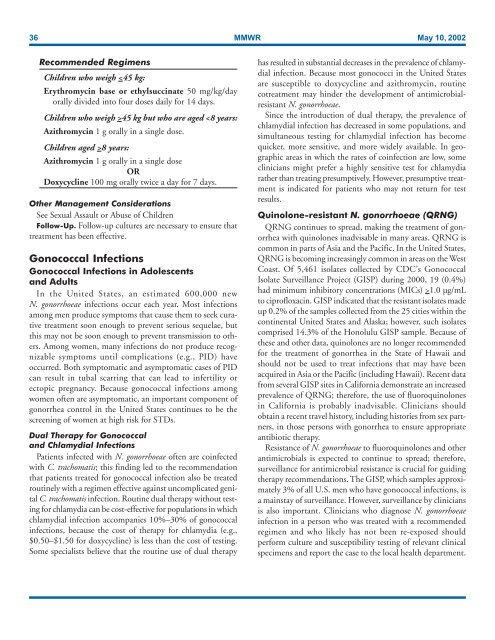You also want an ePaper? Increase the reach of your titles
YUMPU automatically turns print PDFs into web optimized ePapers that Google loves.
36 MMWR May 10, 2002<br />
Recommended Regimens<br />
Children who weigh 45 kg but who are aged 8 years:<br />
Azithromycin 1 g orally in a single dose<br />
OR<br />
Doxycycline 100 mg orally twice a day for 7 days.<br />
Other Management Considerations<br />
See Sexual Assault or Abuse of Children<br />
Follow-Up. Follow-up cultures are necessary to ensure that<br />
treatment has been effective.<br />
Gonococcal Infections<br />
Gonococcal Infections in Adolescents<br />
and Adults<br />
In the United States, an estimated 600,000 new<br />
N. gonorrhoeae infections occur each year. Most infections<br />
among men produce symptoms that cause them to seek curative<br />
treatment soon enough to prevent serious sequelae, but<br />
this may not be soon enough to prevent transmission to others.<br />
Among women, many infections do not produce recognizable<br />
symptoms until complications (e.g., PID) have<br />
occurred. Both symptomatic and asymptomatic cases of PID<br />
can result in tubal scarring that can lead to infertility or<br />
ectopic pregnancy. Because gonococcal infections among<br />
women often are asymptomatic, an important component of<br />
gonorrhea control in the United States continues to be the<br />
screening of women at high risk for STDs.<br />
Dual Therapy for Gonococcal<br />
and Chlamydial Infections<br />
Patients infected with N. gonorrhoeae often are coinfected<br />
with C. trachomatis; this finding led to the recommendation<br />
that patients treated for gonococcal infection also be treated<br />
routinely with a regimen effective against uncomplicated genital<br />
C. trachomatis infection. Routine dual therapy without testing<br />
for chlamydia can be cost-effective for populations in which<br />
chlamydial infection accompanies 10%–30% of gonococcal<br />
infections, because the cost of therapy for chlamydia (e.g.,<br />
$0.50–$1.50 for doxycycline) is less than the cost of testing.<br />
Some specialists believe that the routine use of dual therapy<br />
has resulted in substantial decreases in the prevalence of chlamydial<br />
infection. Because most gonococci in the United States<br />
are susceptible to doxycycline and azithromycin, routine<br />
cotreatment may hinder the development of antimicrobialresistant<br />
N. gonorrhoeae.<br />
Since the introduction of dual therapy, the prevalence of<br />
chlamydial infection has decreased in some populations, and<br />
simultaneous testing for chlamydial infection has become<br />
quicker, more sensitive, and more widely available. In geographic<br />
areas in which the rates of coinfection are low, some<br />
clinicians might prefer a highly sensitive test for chlamydia<br />
rather than treating presumptively. However, presumptive treatment<br />
is indicated for patients who may not return for test<br />
results.<br />
Quinolone-resistant N. gonorrhoeae (QRNG)<br />
QRNG continues to spread, making the treatment of gonorrhea<br />
with quinolones inadvisable in many areas. QRNG is<br />
common in parts of Asia and the Pacific. In the United States,<br />
QRNG is becoming increasingly common in areas on the West<br />
Coast. Of 5,461 isolates collected by CDC’s Gonococcal<br />
Isolate Surveillance Project (GISP) during 2000, 19 (0.4%)<br />
had minimum inhibitory concentrations (MICs) >1.0 µg/mL<br />
to ciprofloxacin. GISP indicated that the resistant isolates made<br />
up 0.2% of the samples collected from the 25 cities within the<br />
continental United States and Alaska; however, such isolates<br />
comprised 14.3% of the Honolulu GISP sample. Because of<br />
these and other data, quinolones are no longer recommended<br />
for the treatment of gonorrhea in the State of Hawaii and<br />
should not be used to treat infections that may have been<br />
acquired in Asia or the Pacific (including Hawaii). Recent data<br />
from several GISP sites in California demonstrate an increased<br />
prevalence of QRNG; therefore, the use of fluoroquinolones<br />
in California is probably inadvisable. Clinicians should<br />
obtain a recent travel history, including histories from sex partners,<br />
in those persons with gonorrhea to ensure appropriate<br />
antibiotic therapy.<br />
Resistance of N. gonorrhoeae to fluoroquinolones and other<br />
antimicrobials is expected to continue to spread; therefore,<br />
surveillance for antimicrobial resistance is crucial for guiding<br />
therapy recommendations. The GISP, which samples approximately<br />
3% of all U.S. men who have gonococcal infections, is<br />
a mainstay of surveillance. However, surveillance by clinicians<br />
is also important. Clinicians who diagnose N. gonorrhoeae<br />
infection in a person who was treated with a recommended<br />
regimen and who likely has not been re-exposed should<br />
perform culture and susceptibility testing of relevant clinical<br />
specimens and report the case to the local health department.


